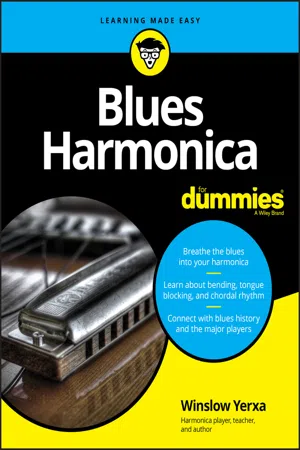
- English
- ePUB (mobile friendly)
- Available on iOS & Android
Blues Harmonica For Dummies
About This Book
Breathe the blues into your harmonica!
Blues harmonica is the most popular and influential style of harmonica playing, and it forms the basis for playing harmonica in other styles such as rock and country. Blues Harmonica for Dummies gives you a wealth of content devoted to the blues approach—specific techniques and applications, including bending and making your notes sound richer and fuller with tongue-blocked enhancements; use of amplification to develop a blues sound; blues licks and riffs; constructing a blues harmonica solo; accompanying singers; historical development of blues styles; and important blues players and recordings.
The accompanying website features all the musical examples from the book, plus play-along exercises and songs that let you hear the sound you're striving for.
- In-depth coverage of major blues harmonica techniques
- Blues song forms, improvisation, and accompanying singers
- Information on blues history and personalities
If you're intrigued by the idea of understanding and mastering the compelling (yet mysterious) art of playing blues on the harmonica, Blues Harmonica For Dummies has you covered.
P.S. If you think this book seems familiar, you're probably right. The Dummies team updated the cover and design to give the book a fresh feel, but the content is the same as the previous release of Blues Harmonica For Dummies (9781118252697). The book you see here shouldn't be considered a new or updated product. But if you're in the mood to learn something new, check out some of our other books. We're always writing about new topics!
Frequently asked questions
Information
So You Wanna Play Blues Harmonica?
Connecting with the Blues



What the Blues Is All About
Blues is about natural expression
Blues gives you a safe kind of musical freedom
- Playing a wrong note in the blues actually takes a lot of effort and planning. Notes that shouldn’t fit according to traditional rules of music theory and harmony somehow always seem to work in the blues. I cover a little bit of music theory in Chapter 3.
- The simplicity of the blues verse makes losing your way kind of hard because you can always tell where you are. Each blues verse is short, consisting of three segments that each begin with a different background chord. You’ll learn to identify those chords as you listen and play. You can even repeat the same melody fragment over all three segments of the verse if you want to. I cover this topic in Chapter 7 and extend it in Chapter 17.
- Repetition is a big part of blues, and so is playing short sequences of as few as three notes — as long as you do so rhythmically. This book is full of these short segments, called licks and riffs. I go into detail on blues harmonica licks and riffs in Chapters 6, 13, 14, 15, and 18.
Why the Harmonica Is Cool All on Its Own
The sound of the blues, built right in
- Some of the notes sound flat compared to the do-re-mi scale. If a blues singer sang a song like “Do-Re-Mi” from The Sound of Music, the first thing you’d notice is that some of the notes sound different because they’re sung at a lower pitch. The lowered notes are called blue no...
Table of contents
- Cover
- Table of Contents
- Introduction
- Part 1: So You Wanna Play Blues Harmonica?
- Part 2: Doin’ the Crawl: Your First Harmonica Moves
- Part 3: Beyond the Basics: Getting Bluesy
- Part 4: Developing Your Style
- Part 5: Taking It to the Streets: Sharing Your Music
- Part 6: The Part of Tens
- Part 7: Appendixes
- Index
- About the Author
- Advertisement Page
- Connect with Dummies
- End User License Agreement